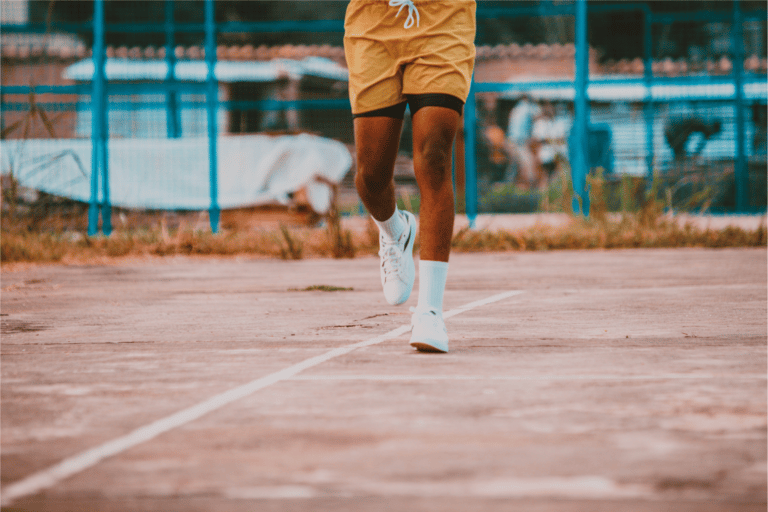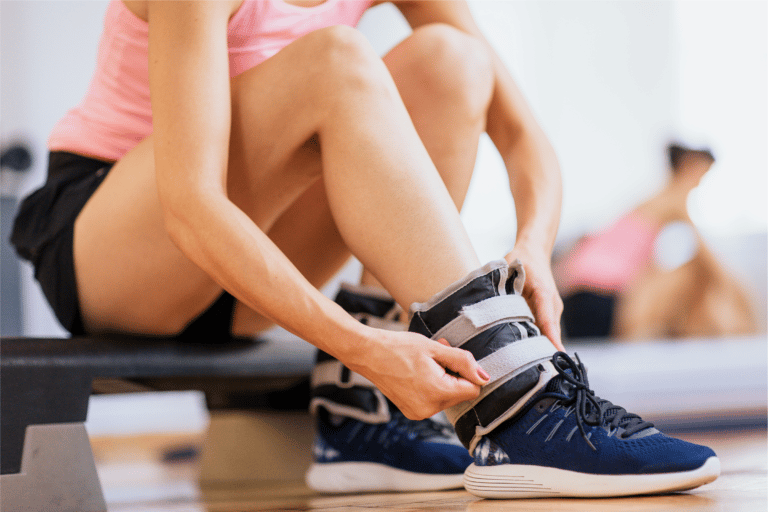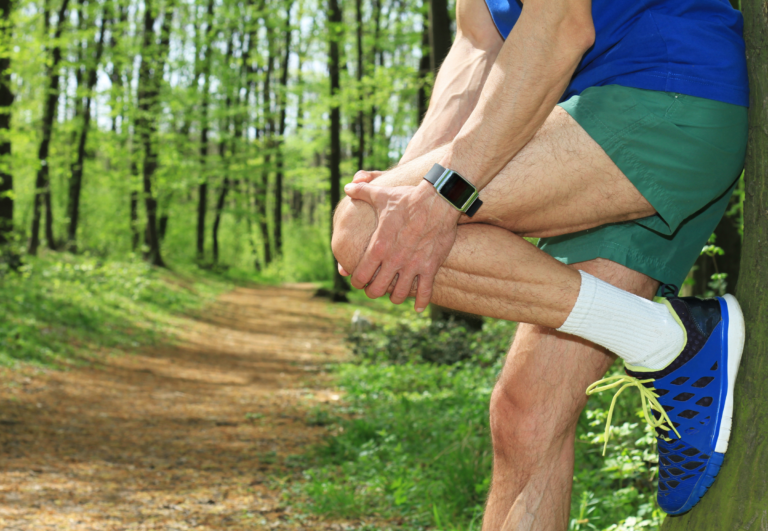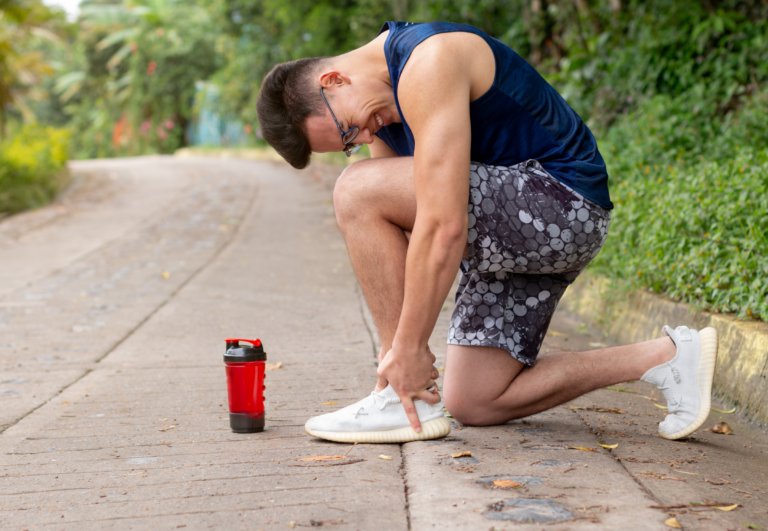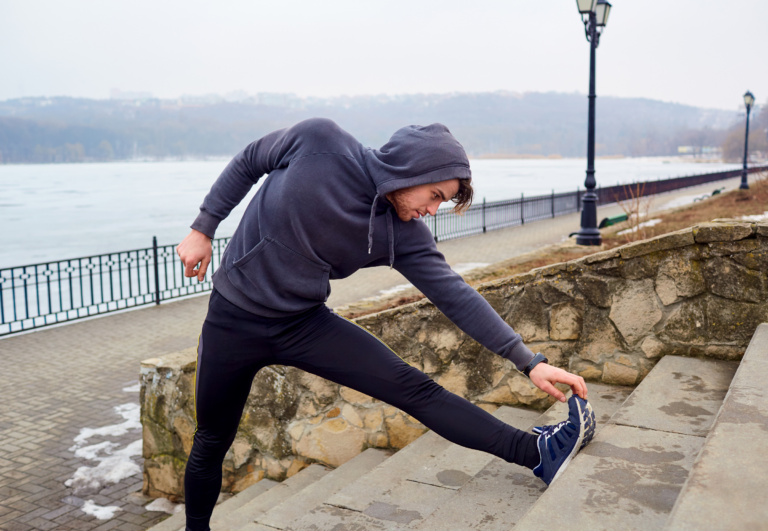Can You Use Running Shoes for Tennis? (What to Look For)
An excellent cardio alternative to running is tennis – it’s a challenging game that provides an opportunity to socialize with friends while enjoying various health benefits. That said, not everybody has the disposable income to buy a ton of tennis gear, especially if only for recreational purposes. Can you use running shoes for playing tennis?
Running shoes can be used for tennis, although purchasing tennis shoes is the optimal solution. Running and tennis shoes are similar, designed for athletic activity and providing comfort and support to their wearer. However, the outsole of tennis shoes is specific to the expected court surface and sideways movement typical of the sport.
Keep reading for the key characteristics of both court shoes for tennis and running shoes, and the key differences between the two.
Is it okay to play tennis in running shoes?
Let me set the scene. You’ve just got home from work, and your best buddy from high school calls you up with an important question: “How about a game of tennis tonight?”
You agree. I mean, who doesn’t want to catch up with an old friend? Then you realize, I don’t have any tennis shoes. Is it okay to play in your running shoes instead?
In a pinch, it is okay to play tennis in your running shoes. If you’re serious about tennis and enjoy it as a hobby, I would recommend picking up court shoes and relegating your running shoes to be used solely for their original purpose: running.
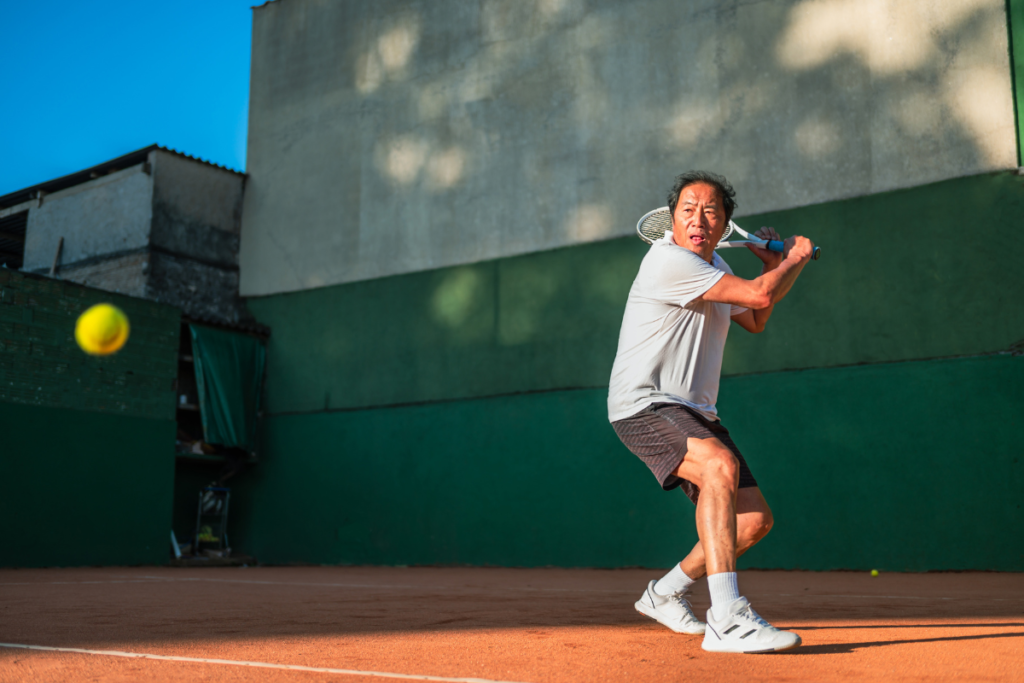
If you have no other options, playing tennis in your running shoes isn’t going to kill you. It will, however, raise your risk of injury and probably have a negative impact on your performance.
Running shoes are cushioned and comfortable, but they’re missing some of the key characteristics that tennis shoes need.
For example, tennis shoes are designed with lateral movement in mind; running shoes are not.
Tennis shoes are also less concerned about cushioning and more concerned with ankle support. Most running shoes have it the other way around.
Like I said, you could definitely get away with it, but playing tennis in running shoes wouldn’t be my first choice!
What are court shoes for tennis – key characteristics
Court shoes are made for playing tennis – as in, to be worn on tennis courts. They’re made to accommodate the high-impact nature of the sport.
Tennis court shoes have three key elements:
- Outsole design
- Cushioning/fit
- Weight
Let’s look at these in more detail.
Outsole design
Quite arguably the most important characteristic of court shoes is the tread.
Court shoes are made with the playing surface in mind; they commonly have specific treading based on the material the court is made of.
If you’re unfamiliar with tennis, there are three types of tennis courts: grass, clay, and hard. Depending on the surface of the court, players need different treads to accommodate their gameplay.
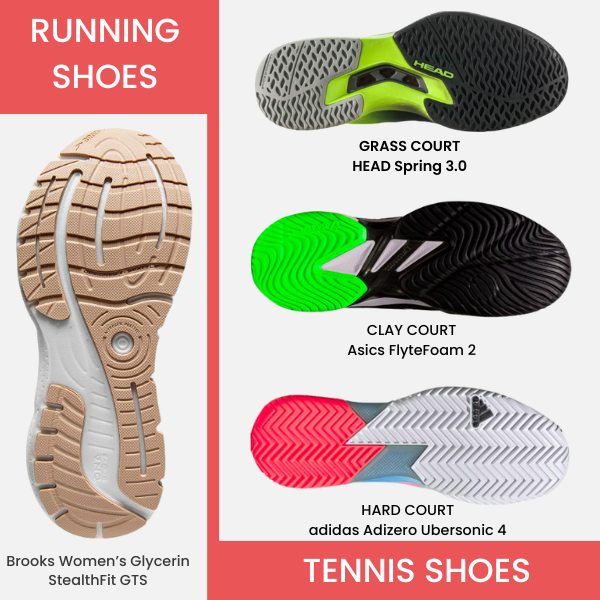
For example, clay-court shoes have a herringbone pattern, while grass-court shoes have a nub pattern. Luckily, large sporting companies now manufacture shoes that can handle all these surfaces.
Cushioning/fit
Tennis is demanding on the joints. Comfortable shoes and adequate cushioning are essential.
Tennis court shoes offer a wide variety of cushioning options, as well as different fits.
As with any sport, there isn’t a one-size-fits-all tennis shoe. Companies offer various levels of cushioning along with wide, regular, or narrow-fitting shoes.
The majority of tennis shoes are stiff to accommodate the sharp, turning movements that players make running back and forth. However, some offer more cushioning than others.
Weight
Similar to how the weight of running shoes is intentionally crafted, the weight of tennis shoes is a key characteristic when deciding what to purchase.
Court shoes’ weight varies based on playing styles.
Without digging into the nitty gritty details, different tennis players need different weights of shoes to accommodate their style of gameplay.
Players who move more will want lighter shoes, while players who hang back and return volleys may sacrifice weight for added ankle support.
What are running shoes – key characteristics
Choosing running shoes is no easy ordeal. Going to your local running store is your best bet, but there are still hundreds of models to choose from!
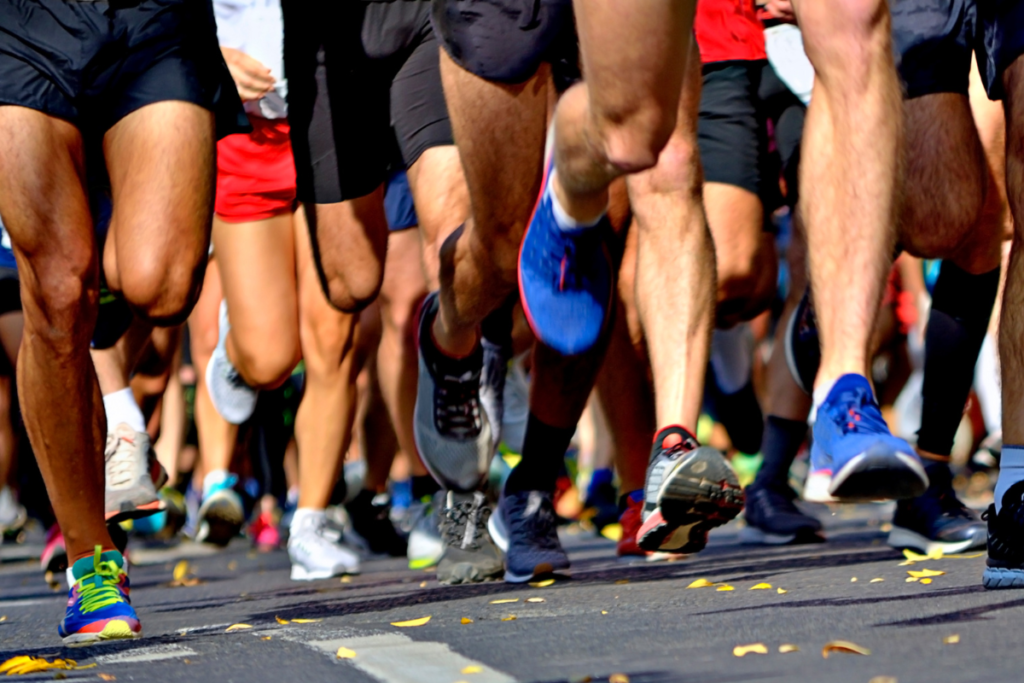
Running shoes must support your feet and keep you comfortable on your runs; this is achieved through the following five characteristics:
- Treading
- Cushioning/fit
- Support
- Materials
- Weight
Let’s take a look at them!
Treading
Depending on where you typically run, you should choose shoes with different treading on the outsole.
Running shoes’ treading is intentionally designed to accommodate specific surfaces such as concrete, outdoor trails, or even the track.
Where you run makes a difference in the running shoes you wear. Various surfaces place different demands on your body, and your shoes must fight by your side to overcome these demands.
Road running shoes are typically outfitted with smooth grooves that are not set very deep into the outsole; trail runners, on the other hand, have deep lugs that help runners grip the trail and avoid slipping.
Cushioning/fit
As you ramp up the miles, you need a running shoe that fits properly and caters to the needs of your feet.
Running shoes have sufficient cushioning to keep runners comfortable while also preventing the risk of injury.
Your daily trainers for running should leave the slightest amount of room for your foot to swell while running, although they shouldn’t be too loose. You would hate for your shoes to fall off!
Cushioning is essential for runners; without it comes an array of injuries and discomfort.
In the end, cushioning comes down to personal preference. Runners can opt for a barefoot feel (minimalist cushioning), cloud-like cushioning (maximal cushioning), or find themselves anywhere in between.
The two biggest determinants for cushioning are the materials the midsole is crafted with as well as the thickness of the midsole.
Did you know having two or more pairs of running shoes can make them both last longer? Learn how in this article!
Support
Every runner has a different foot and foot strike. Finding a running shoe that matches your anatomy is important to an enjoyable running experience.
Running shoes are crafted for one of the three following foot strikes: under pronation (also called supination), neutral, or pronation.
Depending on how your foot distributes your body weight when running has a substantial effect on the running shoes you buy.
For runners who supinate, they’ll need a shoe to compensate; the same goes for runners who are overpronating.
The best way to determine the support you need is to consult a local running store. Typically, these stores can get you fitted and tested on a treadmill for little to no cost!
Materials
Materials are a defining factor in running shoes as they can make or break your running performance and experience.
Another key characteristic of running shoes is the usage of lightweight, breathable materials.
Running shoes are commonly made of some sort of mesh material for breathability. This not only keeps your feet from smelling bad, but it leads to fewer blisters and a lightweight shoe as well.
Some shoes may have other materials like leather or canvas, but they are much less common than mesh. These materials aren’t nearly as breathable, although they are more durable.
Weight
The last thing any runner wants is to be weighed down by their sneaker of choice.
The weight of running shoes is important in performance. Most commonly, running shoes are lightweight; however, weight can sometimes be sacrificed for cushioning or better treading in the case of trail shoes.
Lightweight shoes feel effortless to run in. Instead of feeling like you’re drudging through concrete, light shoes help put some spring in your step.
There’s scientific evidence behind this: minimal running shoes lead to improved running economy. Without the extra weight to drag you down, your running form is more ergonomically efficient.
What is the difference between running and tennis shoes?
Running shoes and tennis shoes share many similarities due to the simple fact that they are both designed for athletic performance.
However, this does not mean they are one and the same. There are certain characteristics that must be distinguished between the two.
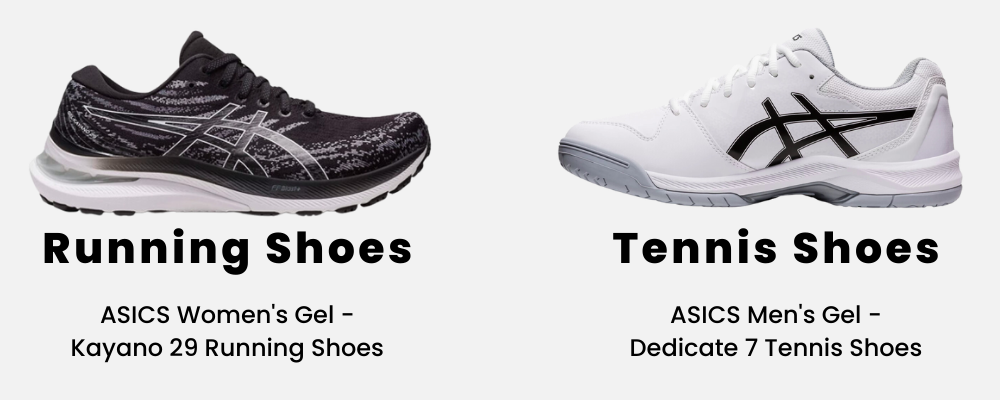
Aside from the obvious fact that running shoes are for running and tennis shoes are for tennis, here are the defining differences:
- Flexibility
- Movement pattern
- Outsole
Let’s compare the two types of shoes based on these criteria.
Flexibility
With sudden changes of direction and rapid movements, tennis shoes must be tough and ready for anything. Running shoes are much more forgiving.
Tennis court shoes are stiff, sometimes designed with a hard toe box to accommodate the high-impact nature of running back and forth on the court. Running shoes do no such thing as they only need to support runners for slower jogs without any sudden changes.
Stiff tennis shoes are a must for durability and excellent performance. Changing direction, as well as planting and pivoting to volley the ball back, demands added protection in comparison to running shoes.
Tennis shoes are so stiff that some wearers complain of them “feeling almost orthopedic”!
Contrarily, running shoes are designed to be flexible and forgiving, the very opposite of tennis shoes. The priority is, without a doubt, cushioning.
Movement pattern
Running and tennis are two totally different sports; the shoes reflect that.
Running shoes are designed for forward movement, whereas tennis shoes are designed for lateral movement. This is reflected by the support and weight of the shoes.
Running shoes are lightweight with little ankle support; tennis shoes tend to be slightly heavier with added ankle support.
When it comes down to it, tennis is more about short bursts of speed with sudden changes in direction. Without the necessary ankle support, you could find yourself with a sprained ankle in the blink of an eye.
So, you could play in running shoes if you don’t have the extra cash for a pair of court shoes, but you need to acknowledge the increased risk of injury inherent in your choice.
Outsole
While both tennis shoes and running shoes have outsoles with high-quality grip, they are made with two different purposes in mind.
Running shoes’ tread varies based on the surface, just as tennis shoes’ treading. However, the treading patterns share next to no similarities.
As mentioned earlier, running shoes are designed for road running, trail running, or a combination of the two.
Tennis shoes are designed for grass courts, clay courts, or hard asphalt courts.
As a result of being designed for different surfaces, the treading patterns are entirely different. So, while playing in running shoes certainly beats playing in sandals, they won’t be able to offer the same grip that court shoes do.


